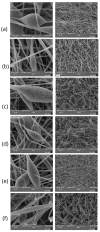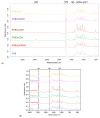Biomimetic Materials Based on Poly-3-hydroxybutyrate and Chlorophyll Derivatives
- PMID: 38201766
- PMCID: PMC10780539
- DOI: 10.3390/polym16010101
Biomimetic Materials Based on Poly-3-hydroxybutyrate and Chlorophyll Derivatives
Abstract
Electrospinning of biomimetic materials is of particular interest due to the possibility of producing flexible layers with highly developed surfaces from a wide range of polymers. Additionally, electrospinning is characterized by a high simplicity of implementation and the ability to modify the produced fibrous materials, which resemble structures found in living organisms. This study explores new electrospun materials based on polyhydroxyalkanoates, specifically poly-3-hydroxybutyrate, modified with chlorophyll derivatives. The research investigates the impact of chlorophyll derivatives on the morphology, supramolecular structure, and key properties of nonwoven materials. The obtained results are of interest for the development of new flexible materials with low concentrations of chlorophyll derivatives.
Keywords: antibacterial properties; chlorophyll derivatives; electrospinning; poly-3-hydroxybutyrate; supramolecular structure.
Conflict of interest statement
The authors declare no conflicts of interest.
Figures








Similar articles
-
Electrospinning of Poly-3-Hydroxybutyrate Fibers Loaded with Chlorophyll for Antibacterial Purposes.Polymers (Basel). 2024 Nov 20;16(22):3221. doi: 10.3390/polym16223221. Polymers (Basel). 2024. PMID: 39599313 Free PMC article.
-
Development of Nonwoven Fibrous Materials Based on Poly-3-Hydroxybutyrate with a High Content of α-Tricalcium Phosphate.Polymers (Basel). 2023 Jul 26;15(15):3167. doi: 10.3390/polym15153167. Polymers (Basel). 2023. PMID: 37571064 Free PMC article.
-
Effect of the Hemin Molecular Complexes on the Structure and Properties of the Composite Electrospun Materials Based on Poly(3-hydroxybutyrate).Polymers (Basel). 2021 Nov 21;13(22):4024. doi: 10.3390/polym13224024. Polymers (Basel). 2021. PMID: 34833324 Free PMC article.
-
Polyhydroxyalkanoates as biomaterial for electrospun scaffolds.Int J Biol Macromol. 2019 Mar 1;124:102-110. doi: 10.1016/j.ijbiomac.2018.11.068. Epub 2018 Nov 13. Int J Biol Macromol. 2019. PMID: 30445089 Review.
-
Recent advances in electrospinning supramolecular systems.J Mater Chem B. 2021 Dec 22;10(1):8-19. doi: 10.1039/d1tb02304g. J Mater Chem B. 2021. PMID: 34878489 Review.
References
-
- Lukyanets E.A. The key role of peripheral substituents in the chemistry of phthalocyanines and their analogs. J. Porphyr. Phthalocyanines. 2010;14:40. doi: 10.1142/S1088424610001799. - DOI
LinkOut - more resources
Full Text Sources

